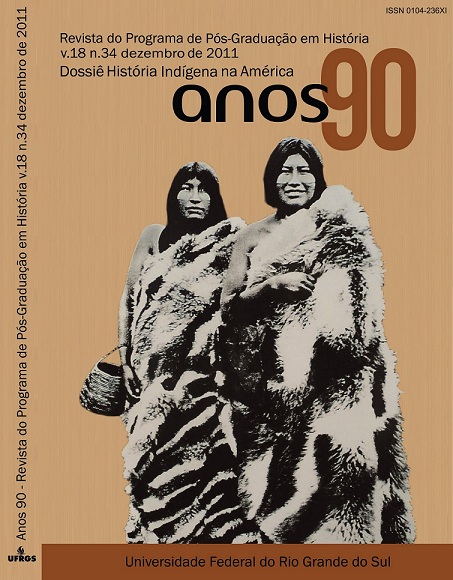Indigenous cultures and the nation: denial or appreciation? The Indian image built by the mexican post-revolutionary indigenism in the first half of the twentieth century
DOI:
https://doi.org/10.22456/1983-201X.24056Keywords:
Indians, Indigenism, Mexico, XX century, national identity.Abstract
This article examines the process of consolidation of indigenism politics in post-revolutionary Mexico in the first half of the twentieth century. Besides the work and thought of Manuel Gamio who had an important role in this process, we demonstrate that the Mexican indigenism politics, directed to the Indians but not run by the Indians, in his first moments assumed an assimilationist attitude of incorporation that was challenged in 1920’s and 1930’s. During this period, there were dissenting voices that highlighted the positive indigenous elements to the formation of the Mexican nation. The Mexican Communist Party, for example, argued in the 1930s the theory of oppressed nationalities and the defense of the autonomy of indigenous peoples. Governmental Indigenism, at the end and after the government of Lázaro Cárdenas, minimize the strength of these dissenting voices and lead an integrationist approach that became hegemonic since the 1940’s with the consolidation of the indigenist governmental institutions.
Downloads
References
BASAVE BENÍTEZ, Agustín F. México Mestizo: Análisis del Nacionalismo Mexicano en torno a la Mestizofilia de Andrés Molina Enríquez. México: Fondo de Cultura Económica, 1992.
CASAS MENDOZA, C. A. Nos olhos do outro: nacionalismo, agências indigenistas, educação e desenvolvimento, Brasil-México (1940-1970). Campinas, 2005.Tese (Doutorado) – Instituto de Filosofia e Ciências Humanas , Universidade Estadual de Campinas.
COMAS, Juan. Manuel Gamio en la antropología mexicana. In: MEDINA, A. e GARCÍA MORA, C. (Ed.). La quiebra política de la antropología social en México (Antología de una polémica). I. La impugnación. México: Universidad Nacional Autónoma de México, 1983.
DAWSON, A. S. From models for the nation to model citizens: indigenismo and the “revindication” of the Mexican Indian, 1920-40. Journal of Latin American Studies, v. 30, n. 2, p. 279–308, 1998.
GAMIO, Manuel. Forjando Patria. 3ª. ed. México: Editorial Porrúa, 1982. (Primeira edição – 1916)
GIRAUDO, Laura. Anular las distancias: los gobiernos posrevolucionarios en México y la transformación cultural de indios y campesinos. Madrid: Centro de Estudios Políticos y Constitucionales, 2008. (Historia de la Sociedad Política).
GUTIÉRREZ CHONG, Natividad. Mitos nacionalistas e identidades étnicas: los intelectuales indígenas y el Estado Mexicano. Tradução de Graciela Salazar. México: Editorial Plaza y Valdés, 2001.
KNIGHT, A. Racism, revolution and indigenismo: Mexico, 1910-1940. In: GRAHAM, Richard (Ed.). The idea of race in Latin America, 1870-1940. 3 ed., Austin, Tx: University of Texas Press, 1994. p.71-113.
LOMBARDO TOLEDANO, Vicente. El problema del índio. México: SepSetentas, 1973.
NAVARRETE, F. Las relaciones interétnicas en México. México: Universidad Nacional Autónoma de México, 2004.
NAVARRETE, F. Una reflexión histórica sobre la discriminación étnica y la desigualdad en México. México: Faculdade de Filosofia e Letras - UNAM: 2007.
SÁNCHEZ, Consuelo. Los Pueblos Indígenas: del Indigenismo a la Autonomía. México, D.F: Siglo Veintiuno Editores, 1999.
ZERMEÑO, G. Between Anthropology and History: Manuel Gamio and Mexican Anthropological Modernity, 1916-1935. Nepantla: Views from South, v.3, n.2, p. 315-331, 2002.



